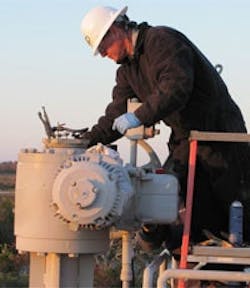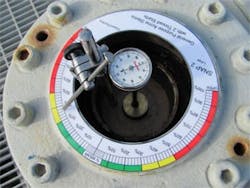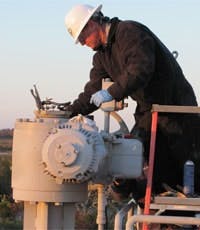Proactive valve system maintenance
The Plant Services Best Practices Awards recognize management techniques, work processes, and product and service implementations that exemplify the definition of a best practice, which the Society of Maintenance and Reliability Professionals (SMRP, www.smrp.org) defines as “a process, technique, or innovative use of resources that has a proven record of success in providing significant improvement in cost, schedule, quality, performance, safety, environment, or other measurable factors that impact the health of an organization.”
Entries must demonstrate how to implement a best practice, show the potential payoffs in both qualitative and quantitative terms, and provide inspiration for those who must overcome cultural inertia and make effective changes. Entries may be submitted by plant personnel, vendors, engineering firms, consultants, or anyone who is familiar with the application and has permission to make it public knowledge. Our 2011 categories also include Reliability, Management, and Energy Efficiency, but this round’s focus is on Equipment.
Contenders offer an impressive reliability practice that can increase productivity, improve efficiency, or reduce costs. Judging criteria included percentage reductions or cost savings, return on investment, and broadness of applicability, with recognition given for innovation and creativity. The winning practice was submitted by Chuck Reames, business manager at The Shaw Group (www.shawgrp.com) in Baton Rouge, Louisiana.
A deepwater port needed a way to test large valves without hours of downtime. Unexpected subtle failures led to uncertainty about the reading that indicated the status of the valve position. In response to this need, the maintenance team was able to develop a new tool that cut the labor cost for inspection and testing by about 90% and yielded a positive payback after testing no more than three valves.
LOOP has about 180 employees, of which 30 are involved in the maintenance operation. A major responsibility at the port is avoiding mechanical failures in the valving system. Leaks that might cause flow interruptions simply can’t be tolerated for economic, safety, and environmental reasons.
When a stem nut on a motor-operated valve (MOV) fails, the control room may have incorrect valve position indication shown, the valve may indicate closed when it is actually open. This is an unacceptable operational condition that demands attention.
At LOOP, when a valve failed to close because of excessive wear on a stripped stem nut, the SCADA system showed the valve to be closed. The failed valve caused an operational condition that was unacceptable. There was a need for a way to allow maintenance technicians to evaluate stem nut condition without having to take them out of service for testing. The failure prompted the facility’s reliability department to investigate a cost-effective way to measure stem nut thread wear to predict potential failures proactively.
“In response, we developed a tool, the stem nut analysis protractor, or SNAP, to measure stem nut thread wear while the valve remains in service,” says Chuck Reames, Shaw Group business manager and co-inventor of the patent-pending SNAP tool with Chris A. Labat, LOOP general manager.
In March 2009, LOOP discovered an MOV with a stripped-out stem nut. Labat was reliability superintendent at LOOP at the time, and Reames augmented the LOOP reliability department, assisting with writing procedures and developing an MOV maintenance program. His background includes computerized MOV diagnostic testing and analysis in the nuclear power industry.
“Back in the mid-1990s, while performing MOV signature analysis, I noticed that a certain event on the valve stem thrust trace could be indicative of stem nut wear and proceeded to research how this event could be used to quantify this wear,” says Reames. “Drawing from my experience in the nuclear industry and understanding the dynamics involved with the event that occurred in the thrust trace and knowing that the cost associated with acquiring the thrust traces from diagnostic testing would be prohibitive, I knew we had to find or develop a simpler and less costly method to measure stem nut wear. Since we were unable to find a reasonable option, we chose to develop the SNAP tool.”
The initial process was to develop the protractor scaling, explains Reames. “Protractors had to be designed for different stem thread designs and to fit different valve stem and actuator sizes,” he says. “Once the math was validated, LOOP engineering designed the layout of the protractors. They then had to be mounted to something cylindrical in shape, and PVC pipe fittings seemed to fit the bill. Then we had to come up with a means of detecting stem movement; a dial indicator was used for this. In order to measure the amount of free rotation, a pointer was used and that could be mounted to any independent structure. The last major element required to measure the stem nut thread wear was to identify that event during the valve stroke where the stem and stem nut threads were not engaged.”
SNAP 2 doesn’t use brass cylinders, but a tool post is screwed directly into the top of the stem nut. With this tool, the protractor is stationary and mounted to the top of the MOV upper bearing housing. This example indicates a 34% thread wear was measured in the close direction.
LOOP’s overall objective is to be more proactive in its maintenance and reliability programs, explains Labat. “During the development and implementation of this predictive technology, I was very pleased with its performance and accuracy,” he says. “Run-to-failure isn’t an acceptable maintenance strategy for MOV stem nuts. The SNAP tool allowed us to define our internal functional-failure point on the P-F curve for MOVs resulting in scheduled replacements of stem nuts before a complete failure. It’s much more cost-effective to inspect the stem nuts while in service and provide the maintenance department time to plan and schedule replacements.”
The device measures stem nut wear when it’s engaged with the threads of a threaded valve stem. The tool mounts on the stem nut while the tool rotates and measures stem nut free rotation (back lash). An indicator shows stem movement. The stem nut is rotated until the stem begins to move. The tool provides a reading that indicates the percent of stem nut wear. Other activities ancillary to the process include removing the stem protector, cleaning the stem, verifying no stem thread wear, reapplying fresh stem grease, and restoring the stem protector ensuring there is no possibility for water or debris intrusion.
LOOP Technician Art Melancon performs a SNAP test on one of the LOOP MOVs.
The tool was designed to be flexible enough to be adapted to a variety of MOV models and sizes. The development process required an understanding of several interactive variables. These included the effects of system pressure, differential pressure, packing loads, and valve assembly design.
When it was rolled out, the two greatest problems the facility encountered were technician buy-in and process development. As with many new technologies, the initial technician acceptance was marginal. The reason appeared to be a cultural resistance to change. But, later, when the new device was able to demonstrate a lengthening track record of success, acceptance improved.
“The most cost-effective method formerly used was to remove the stem nut from the actuator for a visual thread inspection,” says Labat. “This required the valve to be out of service for about nine hours and required 18 labor-hours to accomplish. The new test takes about two labor-hours per valve while the valve stays in service. The total burden doing the visual inspection is $1,620 and for SNAP only $180, yielding a $1,440 savings. Payback occurs after testing only 2.8 stem nuts.”
Shaw and LOOP share ownership of the patent. Currently, Shaw owns licensing rights to the tool and service and is in the process of marketing it as a stem nut analysis service.


